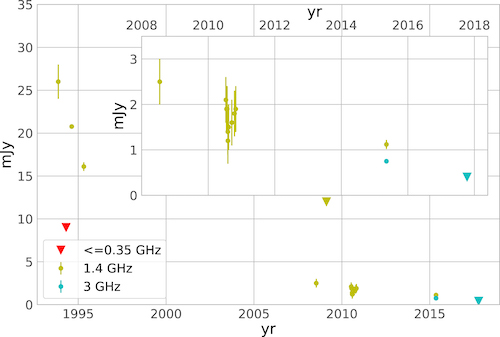Time Domain Science
Radio transients arise from diverse phenomena, including astrophysical blast waves, catastrophic collapses, compact object mergers accompanied by gravitational waves, magnetic acceleration of relativistic charged particles, shocks in high energy particle jets and in magnetized diffuse interstellar plasma, flaring reconnection events in the atmospheres of low mass stars, and the cosmic beacons of rotating neutron stars, white dwarfs, and black hole accretion disks. VLASS now offers the potential to systematically characterize the dynamic sky at radio frequencies, targeting Galactic and extragalactic transient populations. The most numerous radio transients, with the greatest potential impact, belong to populations that are hidden from view at other wavebands, and in some cases are detectable only at radio wavelengths.
VLASS observations will enable searches for transients in multiple ways. Slow transients, with durations from weeks to years, can be found using the VLASS basic data products, in particular the Quick Look images, that are produced rapidly after observation with transient discovery in mind. Fast transients (milliseconds to seconds duration), such as Fast Radio Bursts, will be found using two commensal projects.

Figure 1: Law et al. (2018) used a VLASS upper limit to confirm a long duration transient. This object is the first known candidate "orphan" (i.e. unbeamed) gamma-ray burst.




Connect with NRAO